Nov 24, 2009
A Critique of the October 2009 NCAR Study Regarding Record Maximum to Minimum Ratios
By Bruce Hall, Hall of Records
The NCAR [National Center for Atmospheric Research] study titled “The relative increase of record high maximum temperatures compared to record low minimum temperatures in the U.S.” was published October 19, 2009.”
Abstract
The current observed value of the ratio of daily record high maximum temperatures to record low minimum temperatures averaged across the U.S. is about two to one. This is because records that were declining uniformly earlier in the 20th century following a decay proportional to 1/n (n being the number of years since the beginning of record keeping) have been declining less slowly for record highs than record lows since the late 1970s. Model simulations of U.S. 20th century climate show a greater ratio of about four to one due to more uniform warming across the U.S. than in observations. Following an A1B emission scenario for the 21st century, the U.S. ratio of record high maximum to record low minimum temperatures is projected to continue to increase, with ratios of about 20 to 1 by mid-century, and roughly 50 to 1 by the end of the century.” The following is a graphic representation of the study from the UCAR website (below, enlarged here):
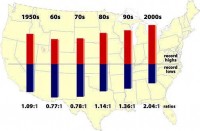
“This graphic shows the ratio of record daily highs to record daily lows observed at about 1,800 weather stations in the 48 contiguous United States from January 1950 through September 2009. Each bar shows the proportion of record highs (red) to record lows (blue)for each decade. The 1960s and 1970s saw slightly more record daily lows than highs, but in the last 30 years record highs have increasingly predominated, with the ratio now about two-to-one for the 48 states as a whole.”
While this study does use sound methodology regarding the data it has included, it falls short of being both statistically and scientifically complete. Hence, the conclusions from this study are prone to significant bias and any projections from this study are likely incorrect.
Comments
The NCAR Study contains at least two biases:
The selection of 1950 through 2006 significantly biases the outcome of this study because the U.S. was entering a cooling period in the 1960s and 1970s which creates the illusion of unusual subsequent warming from 1980 through 2006. During the last decade, a large reduction of rural reporting stations in the U.S. has biased records toward urbanized and urbanizing areas. Land use changes as well as deterioration of urban siting versus NOAA standards [here] have resulted in a bias toward over-reporting/erroneous reporting of high temperature records and an under-reporting of low temperature records.
The charts in the Surface Stations study nearly 4/5ths of the U.S. weather stations and demonstrate a significant bias toward errors greater than +2C or about three times the total trend reported for global warming.
Comparison of Statewide Monthly Temperature Records with the NCAR Study
Let us look at the statewide monthly maximum and minimum records by decade beginning in 1880. Those records are used to calculate a ratio of maximum and minimum records by decade and then compared with the NCAR study ratios (below, enlarged here).

There are two aspects of this comparison that jump out to the reader:
The 1930s were, by far, the hottest period for the time frame. The ratio of maximum to minimum temperatures is greater in the 2000s, but the absolute number of monthly statewide extreme records is far less significant making the ratio far less significant.
The general pattern of ratios for the monthly records follows reasonably closely to the pattern of the daily individual location records, on a decadal basis. Now let us take the two data sets and plot the ratios and see what conclusions we might draw remembering that in absolute terms, the 1930 had a much higher frequency of maximum temperature extremes than the 1990s or 2000s or the combination of the last two decades (below, enlarged here).
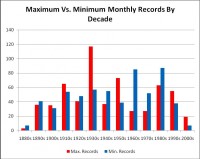
Keep in mind that there are significant biases toward recording daily warmer temperatures due to the closure of thousands of rural stations and expansion of urban areas into previously rural or suburban areas, creating enormous “heat sinks,” that prevent night time temperatures from dropping to the extent that they would in a nearby rural setting. Hence more stations reporting greater frequencies of maximum temperatures and fewer minimums.
Conclusion
The oscillating or cyclical nature of our climate is completely overlooked when one takes a small time frame such as the 1950s through 2006 and extrapolates a full century beyond. Even 130 years of data, starting from a relatively cold period, gives a very brief look at climate history for the U.S. and certainly one that is not sufficient to extrapolate a general warming trend, much less an accelerating one.
In the face of the recent decline in new all-time monthly statewide maximum records, it is more probably that we may be facing a cyclical decline in our overall temperature and that something similar to the 1960s and 1970s may be a far more realistic projection. Our most recent winters have been particularly colder than long-term averages and minimal sunspot activity may be another harbinger of this normal cyclical variation in our relatively stable climate.
For more information about this and related topics, please check out the following blogs: Climate Science, Icecap, Watts Up With That? The authors have contributed ideas and advice for this post. See much more detail in the full post here. See also Roger Pielke Sr.’s post on the NCAR study here.
Icecap Note: Thanks Bruce for this detailed analysis. The NCAR study is another example of a cherry picking study with a period of study beginning near the start of the PDO cold period that started in 1947 and carried through the warm PDO. The current decade of state data is showing fewer records not an acceleration. See comments by Roger Pielke Sr. early this upcoming week here and Anthony Watts here and World Climate Report new here.
Dr. Richard Keen, University of Colorado has added “My book, Skywatch West, covers the weather and climate of the 11 western states, plus Alaska, plus 6 western Canadian provinces and territories. The chapter on temperature extremes includes a chart of the occurrences (by decade) of the all-time extreme temperatures for each of the 18 states, provinces, and territories (a total of 36 records in all) (below, enlarged here). Some fun statistics from this are: of the all-time record maximum temperatures, 10 occurred before 1940 (the first six decades), and 8 after (the second six decades). For record minimum temperatures, the reverse is true: 8 records before 1940, 10 afterwards. Half of the records - 8 maximum and 10 minimum, a total of 18 - occurred during the middle three decades of the 1930’s, 40’s, and 50’s, and of these nearly a third of the total (10) were during the 1930’s alone. No records occurred in the 2000’s up to the publication date of the book (2004). Since then Arizona’s record maximum was tied, but not broken, in 2007.” (below, enlarged here)
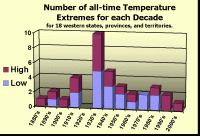
UPDATE: See Bruce’s follow-up study with projections of the observed cyclical trends here.
Nov 24, 2009
All Pain, No Gain
By Paul Driessen
Restricting and taxing energy use to prevent speculative climate disasters would be disastrous. “Electricity rates would necessarily skyrocket” under cap-and-trade,” President Obama has admitted. “Industry will have to retrofit its operations. That will cost money, and they will pass that cost on to consumers.” Cap-and-trade, Senator Ben Cardin (D-MD) eagerly observed, is “the most significant revenue-generating proposal of our time.”
Not one congressman even read the numbingly complex 1427-page Waxman-Markey global warming bill, before the House of Representatives voted on it. A new version of the Kerry-Boxer Senate bill provides no details about how carbon allowances would be allocated under a mandatory emissions reduction program.
The process recalls Churchill’s description of Russia: “a riddle wrapped in a mystery inside an enigma.” Here we are dealing with estimates wrapped in assumptions inside speculation - based on assertions that Earth faces a manmade climate disaster.
The only thing known with certainty is that cap-tax-and-trade will inflict intense pain for no environmental gain - on regions, states, communities, industries, companies and families. It is a complicated regulatory scheme that penalizes businesses and people who use electricity and other forms of energy derived from oil, gasoline, natural gas and coal.
Cap-tax-and-trade would place limits on how much carbon dioxide America would be allowed to generate, and the limits would decrease drastically over time. Companies and utilities would be issued permits, saying how much CO2 they can put into the air each year. If they cannot stay within that limit, they will have to switch to wind, solar, nuclear or geothermal energy (assuming those sources can be built, in the face of regulation and litigation); capture the CO2 and store it somewhere (via technologies that do not yet exist); or buy more permits from US or foreign companies that donít need as much energy (through a new international financial, trading and carbon derivatives market).
Cap-and-trade restricts and taxes hydrocarbon energy use. Because 85% of America’s energy is hydrocarbons, prices will soar for everything we heat, cool, drive, make, grow, eat and do. The impacts will be especially painful in scores of states that depend on coal for 50-98% of their electricity, refine petroleum for the nation’s vehicles, and manufacture products that improve, enhance and safeguard our lives.
The complex system will be administered by profit-seeking carbon management and trading firms, regulated and policed by thousands of government bureaucrats, and paid by every family, driver, business, school district, hospital, airline, traveler and farmer.
The ostensible goal is to stabilize planetary temperatures, climates and weather patterns that have never been stable, by slashing carbon dioxide emissions 83% below 2005 levels by 2050.
The last time America emitted that amount of CO2 was 1908! Once we account for the far lower population, manufacturing, transportation and electrification levels of a century ago, 2050 carbon dioxide emissions would have to equal what the United States emitted after the Civil War!
That would require monumental changes in lifestyles and living standards. It would mean politicians and unelected pressure groups, bureaucrats and judges will limit or dictate home building, heating, cooling and lighting decisions; transportation and vacation choices; how food can be grown and shipped; what kinds of products can be purchased and how they must be manufactured; and how much energy must come from subsidized, unreliable renewable sources.
Restrictions and taxes on fossil fuels will hit our manufacturing heartland especially hard, as it is heavily dependent on coal and natural gas. The American Council for Capital Formation calculated that Waxman-Markey would spike Indiana’s electricity prices nearly 60% by 2030 - increasing school and hospital energy costs 28-42% and causing numerous jobs to be exported to Asia, where there will be few restrictions on CO2 emissions. Numerous other states would be similarly hard hit, says ACCF.
Other experts have calculated that cap-and-trade would destroy millions of American jobs, raise energy costs for the average US family by $1,400 to $3,100 per year and send overall food and living costs upward by $4,600 annually. Will you be able to afford that?
Poor families may get energy welfare. Wealthier families can absorb these costs. But cap-and-trade will severely affect middle class families. They would be forced to pay skyrocketing energy and food costs, by cutting their college, retirement and vacation budgets. Hospitals and school districts would have to raise fees and taxes, or cut services. Cities and states would have to cover rising welfare and unemployment costs, as tax revenues dwindle. Tourism-based businesses and economies would get hammered.
Switching to renewable energy does not merely increase costs and reduce reliability. It also affects the environment. Ethanol mandates would mean growing corn or switchgrass on farmland the size of Montana, and using vast amounts of water, fertilizer, diesel fuel, natural gas and insecticides.
Wind and solar power would mean covering millions of acres of scenic, habitat and farm land with huge turbines and solar panels. Hundreds of millions of tons of concrete, steel, copper, fiberglass and “rare earth” minerals would be needed to build them and thousands of miles of new transmission lines to get the expensive renewable electricity to distant cities. Because the turbines and panels only work 10-30% of the time, back up natural gas generators would also be needed, meaning still more raw materials.
Even worse, all this pain would bring no benefits. Using global warming alarmists’ own computer models, climatologist Chip Knappenberger calculated that even an 83% reduction in US carbon dioxide emissions would result in global temperatures rising just 0.1 degrees F less by 2050 than not cutting US carbon dioxide emissions at all.
That’s because CO2 emissions from China, India and other countries would quickly dwarf America’s job-killing reductions. These nations are building a new coal-fired power plant every week and putting millions of new cars on growing networks of highways - to modernize, reduce poverty, improve human health, and ensure that families, offices, schools and hospitals have electricity. Germany plans to build 27 new coal-fired power plants by 2020, and Italy expects to double its reliance on coal by 2015.
Moreover, the 0.1 degree temperature reduction assumes rising CO2 causes global warming - a belief that thousands of scientists vigorously challenge, because there is little actual evidence to support the thesis.
Of course, some will gain from penalizing, taxing and hyper-regulating our economy. Al Gore and others involved in emission trading stand to make billions, from trillions of dollars in cap-and-trade transactions. Coastal states and companies that don’t rely on coal will benefit, as will companies that get excess or low-cost emission permits and can sell these allowances for handsome profits. Well-paid bureaucrats will have “green jobs” - as will scientists, eco-activists and renewable energy companies, who will share $6-10 billion annually in taxpayer cash, as long as they continue to conduct biased climate research, issue dire warnings about global warming cataclysms, and build wind and solar projects.
Besides massive pain for no gain, cap-tax-and-trade will create an intrusive Green Nanny State that destroys jobs, reduces personal freedoms, and hobbles economic opportunities and civil rights. Our Earth is cooling. Our economy is in the tank. Congress and the White House need to stop hyperventilating about global warming, and let the free market get our economy back on track.
See PDF here. See also these two posts “Modelers History of Climate Change” here and “Al Gore, Junk Science Huckster” here.
Paul Driessen is senior policy adviser for the Committee For A Constructive Tomorrow (CFACT), which is sponsoring the All Pain No Gain petition against global-warming hype. He also is a senior policy adviser to the Congress of Racial Equality and author of Eco-Imperialism: Green Power - Black Death.
Nov 20, 2009
Alumni Letters Coming to Penn State Calling for Investigation of Michael Mann
One such example below is from PSU meteorology grad Herb Stevens who has been in television meteorology at The Weather Channel, in local television in Albany and then throughout the northeast as the “Skiing Weatherman”. Herb serves as a forecaster and advisor to ski areas and golf courses across the country and was a caddy on the PGA tour. See plea at end of letter.
November 23, 2009
Dear Dr. Spanier:
In recent days, nearly a thousand emails from the University of East Anglia Climate Research Unit have been released for public scrutiny. They were obtained either through the actions of a hacker, or an inside whistleblower. While not condoning any illegal activities, I have read most of the emails and have found a good number of them to be very disturbing due to the participation of Dr. Michael Mann of Penn State’s Earth System Science Center. Based on the content of the emails, Dr. Mann, whose scientific methodologies have already been discredited with respect to his “hockey stick” temperature graph, seems to have been involved in an ongoing pattern of data manipulation, intimidation of scientific journal editors, constraint of the peer review process, and attempted avoidance of compliance with the Freedom of Information Act. As a Penn State meteorologist who has been active in the public discussion of climate change for more than ten years, I can attest to the fact that Dr. Mann’s reputation, and by extension that of Penn State, has been significantly sullied in recent years. These new revelations of Dr. Mann’s methods and actions will only exacerbate the situation and serve to darken the shade of the black eye currently sported by the University’s Earth Sciences Department.
In my opinion, Dr. Mann should be relieved of his duties based solely on the deceptive methods used in the creation of the hockey stick. If any of the matters seemingly revealed in the CRU emails have a shred of truth to them, then your course of action should be very simple...Dr. Mann must be terminated from his contract with The Pennsylvania State University.
I sincerely request that you look into this matter, recognizing that Dr. Mann’s presence on the faculty is undoubtedly responsible for a sizable amount of grant money. The money be damned. I would hope that you hold the members of the faculty to the standard so eloquently stated in the 4th verse of our Alma Mater..."May no act of ours bring shame, to ONE heart that loves thy name...May our lives but swell thy fame, Dear old State, dear old State.”
Thank you for your consideration of this matter.
Respectfully,
Herbert E. Stevens
North Kingstown, RI
Meteorology-1975
I appeal to all graduates of Penn State, and especially those of you who studied atmospheric sciences...If you believe as I do that Dr. Mann’s presence on the faculty has become a liability to the reputation of our alma mater, please let your feelings be known to President Graham Spanier. His email address is president@psu.edu. Thank you very much.
Also see this post by another Penn State grad and well known meteorologist Joe Bastardi on Climategate and Mann-made Global Warming here.
Nov 12, 2009
Arctic Heats Up. Spitsbergen 1919 to 1939
By Arndt Bernaerts
Excerpts from Introduction: Arctic Warming - What Warming?
The claim that the summer of 2007 was apocalyptic for Arctic sea ice has recently gone around the globe, because the coverage and thickness of the sea ice in the Arctic has been declining steadily over the past few decades. For many scientists this situation appears to be related to global warming (Bronnimann, 2008). In 2003 a USA research center formulated it this way already: “Recent warming of Arctic may affect worldwide climate”. Not everyone agreed but quarrel: What Arctic Warming?
Although there is hardly a convincing reason to neglect the recent warming in the Arctic and the extent of ice melt during the summer season, it is not necessarily clear yet, whether the current discussion is based on a sound and comprehensive assessment. Climate research should not only deal with Arctic warming based on observations made during the last few decades, but at least be extremely interested in other climatic events that occurred in modern times, especially if somehow in connection with the situation in the Arctic. Why?
On the 2nd of November 1922, The Washington Post published the following story: Arctic Ocean Getting Warm; Seals Vanish and Icebergs Melt”. The corresponding report in the Monthly Weather Review of November 1922 had also stated that the ice conditions in the Northern North Atlantic were exceptional; in fact, so little ice has never before been noted. Only 16 year later the meteorologist C.E.P. Books thought it necessary to explain the situation more complex:
In recent years attention is being directed more and more towards a problem which may possibly prove of great significance in human affairs, the rise of temperature in the northern hemisphere, and especially in the Arctic regions. (Brooks, 1938) At the time of the writing of these lines in 1938, the Arctic had got as warm as in the first decade of the 21st Century. How much do we know about the mechanism that caused the previous arctic warming? Not very much, as Bronnimann et a. acknowledged: “Our understanding of the climate mechanism operating in the Arctic on different timescales is still limited” (Bronnimann, 2008). Is it reasonable and fair to dramatize the shrinking sea ice during a recent time period, if one is not fully aware of what happened in the early years of the last century?
The focus is clear: What role did the ocean play? The investigation will prove that it had been substantial, by time, intensity and duration. But once these aspects have been thoroughly elaborated, the discussion will be extended to the question: Why? After all, the first arctic warming began at the end of the World War One in the winter of 1918-19, and died away when the Second World War began on the 1st of September 1939. That is worth a discussion, even if it is not the purpose of this paper to offer conclusive evidence in this respect.
The Arctic Is Screaming?
The world should know: The Arctic is Screaming noted newspapers recently. No one had heard the Arctic crying, but was there something that should have signaled horror? It is true; the annual arctic sea ice cover had been decreasing during the summer season for a couple of years. The remaining minimum ice cover around September produced record after record: the record from 2005 was beaten by 2006, which was beaten by 2007. That was the point when the emigre in polar science Mark Serreze informed the press: “The Arctic is screaming”. As a senior scientist at the government’s snow and ice data Center in Boulder, Colorado, Mark Serreze should know what he is talking about, or had it been his scream? At least the time for setting a scream was timely. Special legislation for polar bears was already on the way, as it was assumed that the dwindling sea ice would not leave the bears without ice floats but affecting wildlife widely.
“Greenland’s ice sheet melted nearly 19 billion tons more than the previous high mark, and the volume of Arctic sea ice at summer’s end was half what it was just four years earlie. At this rate, the Arctic Ocean could be nearly ice-free at the end of summer by 2012, much faster than previous predictions”, the NASA climate scientist Jay Zwally was cited. But even this prediction could be topped by arctic experts claim to a conference meeting that, if the Arctic sea ice was melting so rapidly, as it recently did, than any sea ice throughout the Arctic Ocean could have entirely disappeared by the summer of 2040.
In this context, the CNN could observe that scientists have been asking themselves these questions: Was the record melt seen all over the Arctic in 2007 a blip amid relentless and steady warming? Or has everything sped up to a new climate cycle that goes beyond the worst case scenarios presented by computer models? Nobody has given any answer. But Mark Serreze says: the Arctic is screaming. Is it impossible to find out?
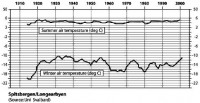
It should not be impossible, as the present arctic warming since 1980 is not the only one. There was another warming period for the region north of 62o North since 1920 until 1945, for which the high-latitude temperature increase was stronger in the late 1930s early 1940s than in recent decades (Polyakov, 2002). The first Arctic warming started 90 years ago, from about 1920 to 1940. In winter 1918-19 the air temperatures exploded at the remote archipelagos Spitsbergen, which the Norwegian call: Svalbard. In 1930 the Norwegian scientist. B. J. Birkeland regarded the rise as maybe the biggest ever observed in one place. Birkeland could presumably repeat the claim today with justification. But would he or his colleagues come up with the exclamation the Arctic is screaming today? Definitely not, although he and his colleagues might wish to scream: How could it be that you know so little about “our arctic warming” to understand “your arctic warming”.
One may only recall a report by the New York Times in 1932 to realize what it could mean when the substance of claims are not clear: “Next great deluge forecast by scientists - Melting polar ice caps to raise the level of the seas and flood the continents”. Is that very different from current claims? At least, C.E.P. Brooks (1938) had that to say with regard to this warming period: “There have been great climatic oscillations before this, even since the last Ice Age, about the causes of which we are quite ignorant”. It seems little has changed when now confronted with the mere allegation, that the warming the NYT and Brooks are talking about has been due to natural variability, even without explaining which part of nature did something, and which did not.

See larger here.
The following investigation will show that the 1st Arctic warming was not understood in the 1930s, and that little has changed to better at the end of the first decade of the 21st century, about seven decades later. What is needed is a better understanding of what had happened almost a century ago in the high northern hemisphere, and this work does not agree with NASA expert Waleed Abdalati notion: “The first step in understanding why things happen is observing what is happening”. See how ice edge has varied in other years below (enlarged here).

See the full book, a fascinating read, downloadable here.
Nov 11, 2009
New geologic evidence of past periods of oscillating, abrupt warming, and cooling
By Dr. Don Easterbrook
Two hundred years ago, Charles Lyell coined the phrase “The present is the key to the past.” In today’s highly contentious issues of global climate change, we might well add “The past is the key to the future”, i.e., to forecast future geologic events, we must understand past climate changes. This paper documents past global climate changes in the geologic and historic past.
Recent laser imaging of the Earth’s surface provides new evidence for abrupt, fluctuating, warm and cool climatic episodes that could not have been caused by changes in atmospheric CO2. In a paper presented at the national meeting of the Geological Society of America in Portland, OR, Professor Don J. Easterbrook, Professor of Geology at Western Washington University, presented new data from airborne laser imagery showing well-defined, previously unknown, multiple moraines deposited by glaciers 11,700 to 10,250 years ago. At least 9 significant, abrupt periods of warming that resulted in retreat of the Cordilleran Ice Sheet are documented by moraines from successive glacial retreats in the Fraser Lowland of NW Washington l(Fig. 1). In addition, smaller multiple glacier recessions are found within the more prominent episodes of glacier retreat. As indicated by the amount of glacier recession between each of the successive moraines, the warming events were of greater magnitude than those observed in recent centuries.
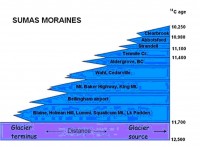
Figure 1. Successive terminal moraines from short-term glacier recessions caused by climatic warming between 11,700 and 10,250 years ago.
Isotope data from Greenland ice cores and show a consistent pattern of fluctuating warm and cool periods over the past 500 years (Fig. 2). The average period of warming/cooling oscillations over the past 500 years is 27 years, remarkably similar to the period of alternation between warm and cool Pacific Decadal Oscillation.

Figure 2. Paleotemperatures derived from oxygen isotope measurements of the GISP2 Greenland ice core. Red peaks are times of warming and blue are times of cooling. The average time period for each climatic oscillation is 27 years.
During the past century, two episodes of global warming and two of global cooling have occurred (Fig. 3), all of which can be tied to glacial oscillations, oceanic temperature changes, atmospheric temperature changes, and solar variation.
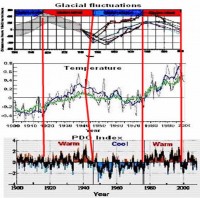
Figure 3. Coincidence of Pacific Decadal Oscillation (PDO), global temperature, and glacier fluctuations in the North Cascades. Glaciers advanced during the 1880-1915 cool period when the PDO was cool, then when the PDO switched to its warm mode, global temperatures warmed, and glaciers retreated from ~1915-1945. The PDO changed from warm to cool ~1945-1977, global temperatures cooled and glaciers advanced once again. In 1977, the PDO switched from cool to warm mode, global temperatures warmed, and glaciers retreated. In 1999, the PDO changed back to its cool mode and global cooling began.
What we can learn from this geologic climate changes is that the past is indeed the key to the future. In 1999, the year after the warmest year of recent times, I projected the climate pattern from the past century and past 500 years into the future and predicted that we would be due for 25-30 years of global cooling beginning about 2000. The PDO changed from its warm to cool mode in 1999 and since then we have had global cooling, quite moderate to flat (interrupted by two warm El Ninos) and intensifying since 2007.
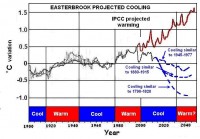
Figure 4. Projection of climate changes of the last 4century and past 500 years into the future. The black curve is temperature variation from 1900 to 2009; the red line is the IPCC projected warming from the IPCC website in 2000; the blue curves are several possible projections of climate change to 2040+ based on past global cooling periods (1945-1977; 1880 to 1915; and 1790 to 1820). The lack of sun spots during the past solar cycle has surpassed all records since the Dalton Minimum and some solar physicists have suggested we may be headed for a Dalton or Maunder type mimimum with severe cooling. See more in PDF here.
|













